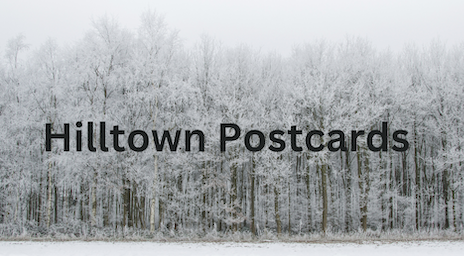Here is the next Hilltown Postcard, which focuses on our first winter in Worthington. Luckily, we had good people to advise us and we had experienced another winter in a more primitive rural setting. We did get smarter and better prepared for winter the longer we lived in the hilltowns.
It got cold then colder that first winter in Worthington. The weather had been harsh in Boston, with the wind coming off the ocean, but at least the apartment we rented in the Jamaica Plain section had reliable heat and insulation. That wasn’t true of the house we rented in Ringville.
We seriously doubted the walls had any insulation, maybe crumpled newspaper, so we wrapped tar paper along the house’s exterior on its north side to seal it along with the snow that would collect there. One of the locals, probably the helpful Win Donovan advised us to do that.
The windows were single-paned. Our only source of heat was a wood stove we bought that really was just a box of black metal that gave off enough heat for the first floor. The windows on the second, where the kids’ bedrooms were, had thick ice on the interior. The Donovans gave us rectangular blocks of marble we heated on the wood stove and wrapped in flannel to place at the foot of their beds before we piled on the blankets.
We had a washer, an apartment-sized one, but no dryer. So, I used to hang the laundry on a line with a pulley from the back door. The clothes would freeze one day and the water would evaporate the next. We did have a wooden drying rack near the wood stove. It was a bit of a challenge since our youngest kid was still in diapers.
This wasn’t our first winter in the country. Five years earlier, Hank and I moved with two kids to the sticks of New Hampshire, a town called Wilmot. We rented a house 8 by 24 feet. No electricity. Water came from the stream running beside it. We had an outhouse and a woodstove.
A farmer on the road sold us cords of firewood that we stack between the trees in rows. Being rookies, we used to start our wood stove’s fire with kerosene, I swear it’s true, and it’s a miracle we didn’t blow up the house. But once the stove got going, the house was indeed warm, especially since we chose to live only on the first floor.
We had a battery-operated radio that managed to bring in one National Public Radio station. At eight o’clock we looked forward to hearing a reading of Laura Ingalls Wilder’s ‘Little House’ series on the Spider’s Web show. Her book “The Longest Winter” had a special meaning.
Hank was driving truck for a natural foods company in Boston. After the pickup truck we bought turned out to be a lemon — we had to abandon it in a field when the brakes gave out and someone who stopped said it was a rusted piece of junk — and before we could buy a VW Bug from good neighbors, he had to hitchhike. He was gone for several days, sometimes longer, and when my supply of split hardwood dwindled to nothing, I asked a neighbor to show me how. I placed one log on top of another and with the swing of a maul, I got it done. I actually became quite good at it.
But I didn’t have to do much of that in Ringville. Hank used a chainsaw to cut down ash trees, which we were told can be burned green.
The snow was serious. The VW Bus had decent traction. All we had to do was shovel it out. We didn’t need another vehicle since I didn’t have a driver’s license in those days. That’s fodder for another post. The main road was State Highway 112, which was maintained well. We’d see the plow truck’s strobing lights as it passed.
Hank found some work with people he knew in Boston. Due to the repairs done on the house, we were paying hardly any rent. We somehow managed to keep up with electricity, food, and gas for the car. The phone was cheap in those days. (We only had to dial four numbers then to reach anyone within Worthington.) There was no such thing as the internet. All of my correspondence was done by mail and the landline.
My mother would send boxes of clothes for the kids. One time she included a copy of Midsummer Night’s Dream that had been owned by my teacher during my high school freshman year.
That winter we got to know what the town had to offer, like the small library that I visited weekly to stock up on books, the general store, and a monthly food co-op held at the school where our kids went. We became familiar with the people who lived there, including the neighbors, and what they did for fun in the winter.
Worthington seemed to be a good place to live.
INSPIRATION: The hilltowns of Western Mass. are the inspiration for much of my fiction. You can check out my books, including a mystery series, here.

